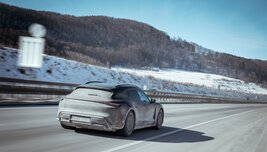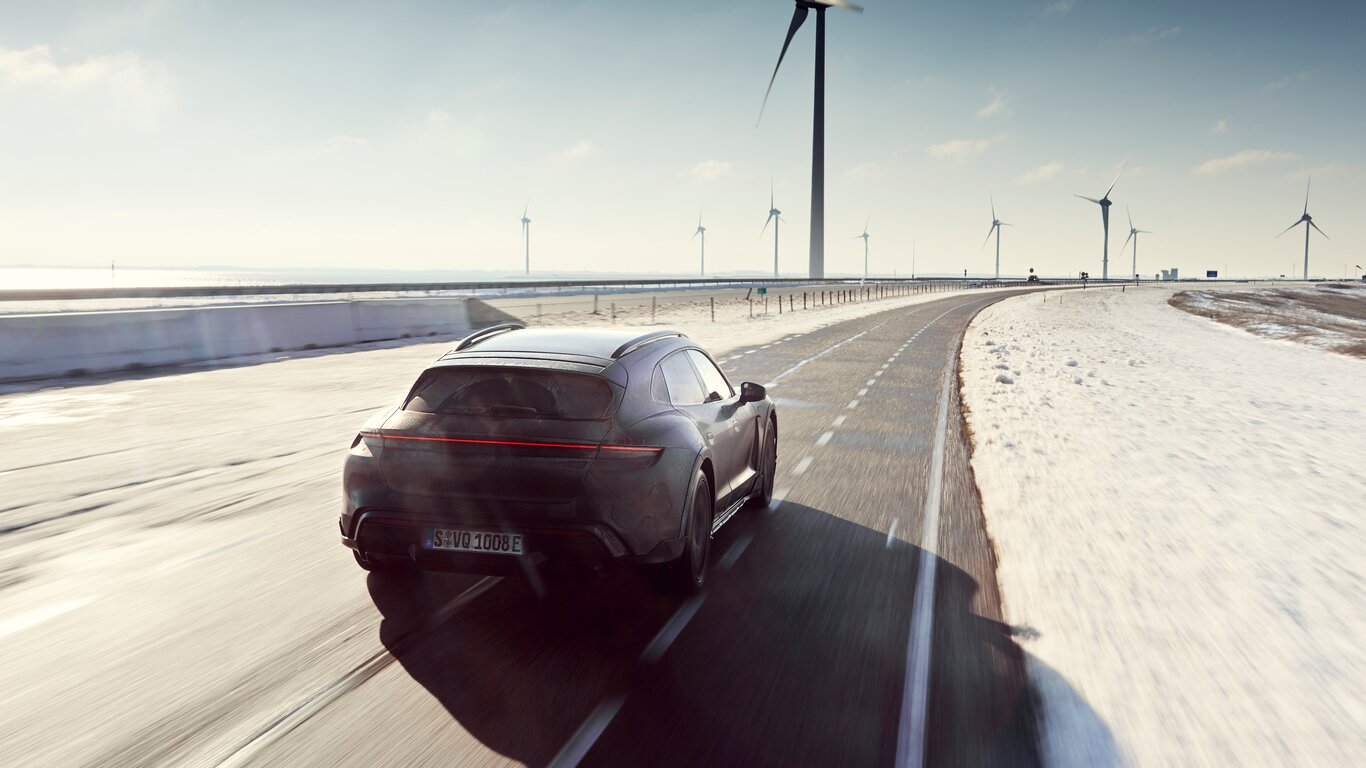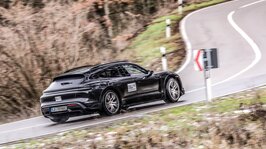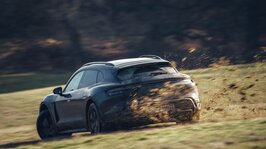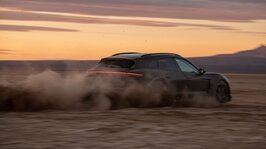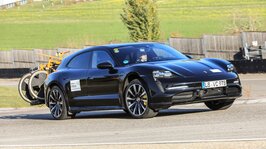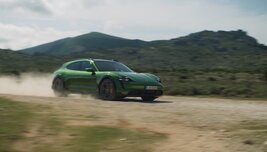The highly praised design contours familiar from the Taycan sports saloon can also be found in the new variant's interior: the wing-shaped upper and lower sections of the dashboard stretch across the entire width of the vehicle. The free-standing, curved instrument cluster forms the highest point on the dashboard. A central 10.9-inch infotainment display and a further, optional front passenger display are combined to form an integrated glass band in a black-panel look.
A compass mounted on the top of the dashboard is optionally available. This shows the direction the car’s heading in in analogue form by means of a rotating compass rose and provides information on altitude and time on a digital display.
Thanks to the new model's modified roofline, the up-to-three rear-seat passengers that the Cross Turismo can carry enjoy 47 mm more headroom than in the Taycan. The large tailgate provides easy access to the rear luggage compartment of the Taycan Cross Turismo: with a width of 776 mm and a height of 538 mm, the opening is much wider and higher than on the saloon (445 and 325 mm respectively). Depending on the equipment specified, the rear luggage compartment has a capacity of up to 446 litres (saloon: 407 l). This even increases up to 1,212 l when the rear-seat backrests, which can be split 60:40, are folded forward. The front compartment offers an additional 84 l. A partition net, bag hooks and tie-down straps (optionally available in the stowage package) ensure that the rear loadspace remains tidy.
The luggage compartment cover is an example of the high amount of development time that Porsche has invested into even the smallest details. The cover can be stowed behind the rear seat bench to save space because it does not have any side lugs and is therefore narrower than the luggage compartment. Instead, the four lugs are folded out of the side trim and can also be used as bag hooks. The cords for securing the cover on the tailgate can be clipped into the cover when it is removed.
Four display modes for the instrument cluster
The innovative instrument cluster consists of a 16.8-inch curved display with the rounded shape that is characteristic of Porsche. There is no cowl, which ensures a slim and modern appearance in the style of high-quality smartphones and tablets. Drivers can choose between four display modes for the instrument cluster:
-
Power Meter mode evokes the round instruments typical of Porsche. This display delivers clearly arranged information for fast readability. A power meter replaces the rev counter as the middle instrument.
-
Map mode replaces the central power meter with a map section.
-
Extended Map mode replaces the round dials with a navigation map, which is shown across the full display.
-
Reduced mode is limited to essential driving information such as speed, road signs and navigation instructions using a minimised arrow.
-
The optional Night View mode makes this display the central element.
The small, touch-control panels at the edges of the screen operate the lights and chassis functions. The instrument cluster is therefore wider than the steering wheel and reminiscent of the original 911.
A colour head-up display is available on request. This projects relevant information directly into the driver’s field of vision. The display has been divided into a main display section, status section and a third section that shows temporary content, such as calls or navigation information. A navigation display, power meter and a user-defined view can also be selected as pre-sets.
The steering wheel has a lightweight appearance visually and is available in two versions: in addition to the multifunction sports steering wheel in leather, which can be personalised with colour inserts as part of the Accent package, Porsche offers the GT Race-Tex multifunction sports steering wheel as an option. It has a distinctive design with visible screw heads and features a round Drive Mode switch, which is characteristic of Porsche and can be used to select the various driving modes.
The wing-shaped upper and lower sections of the dashboard stretch across the entire width of the vehicle. A central 10.9-inch infotainment display and optional passenger display are combined to form an integrated glass band in a black-panel look, which blends in visually with the interior.
All user interfaces with clear layout
Control is always intelligent and intuitive, using touch operation or the voice control function, which responds to the command “Hey Porsche”.
All vehicle configurations for the Taycan, such as Porsche Active Suspension Management (PASM), can easily be set up on the central screen directly. The driver can quickly access all apps via a clearly structured and customisable home screen. Apps include navigation, telephone, media, comfort and Porsche Connect. With the optimised voice control function, drivers can access their required function even faster. Front passengers in the Taycan Cross Turismo also have the option of their own touch display, allowing them to easily adjust settings without distracting the driver.
The elevated centre console intensifies the feeling of a low, sporty seating position, as you would expect from a Porsche. It features a large 8.4-inch touch panel with haptic feedback. This allows the air-conditioning settings to be adjusted directly. Integrated handwriting recognition also allows addresses to be entered quickly.
Every detail has been reduced to the essentials. Like the Porsche 918 Spyder, the Taycan Cross Turismo has a compact gear selector switch in the instrument panel instead of the classic selector lever. This gives the centre console a tidy look and creates storage space. A reduction to the essentials and a clear approach are also evident in the design of the air vents. They have been fully modernised and can be operated intuitively. Traditional, mechanically operated louvres belong in the past, as airflows are now controlled both digitally and fully automatically (Virtual Airflow Control). By clicking the Climate menu, it is possible to switch between Focused for fast, directional cooling and Diffused for draught-free air conditioning. If the optional four-zone automatic climate control system (Advanced Climate Control) has been ordered, an additional 5.9-inch touch control panel with haptic feedback allows the system to be operated from the rear seats.
A wide range of personalisation options and innovative material concepts
The colour and material concept of the Taycan Cross Turismo allows for individualised equipment, from traditional through to sustainable and modern. As standard, the Taycan Cross Turismo comes with a partial leather interior as well as front comfort seats with eight-way electrical adjustment. There is the option of classic leather as well as the sustainably tanned Club Leather OLEA, which uses olive leaves in the tanning process. The natural quality of the leather is accentuated by a special cloud print. A new feature is the fully leather-free interior with state-of-the-art surface textures. Race-Tex material, which is a high-quality microfibre material partially consisting of recycled polyester fibres, is used here. The floor covering uses the recycled fibre Econyl®, which is made in an innovative production process using recycled fishing nets, among other things.
The Taycan Cross Turismo is available with a wide range of interior and exterior configurations in traditional and modern styles. Interior accents and trims underline the attention to detail, while meeting the highest quality standards typical of Porsche in terms of material characteristics and workmanship. In addition to the Black/Lime Beige, Blackberry, Atacama Beige and Meranti Brown interior colours, customers can also create special contrasts in their car's interior with the optional Accent package. Customers can choose from Matt Black, Dark Silver or Neodyme, an elegant champagne tone. The trim of the doors and centre consoles can be made of wood, matt carbon, embossed aluminium or fabric.
In addition to the host of innovations, there is another detail that should not be missing on any Porsche: as with the ignition lock on conventional Porsche models, the power button is located on the left behind the steering wheel.

